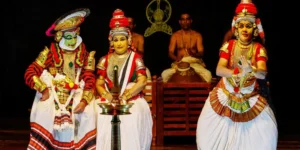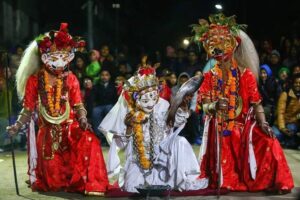UNESCO List of Intangible Cultural Heritage.
Cultural heritage does not mean only the collection of monuments and objects. It also includes the tradition of inheriting one’s ancestors to one’s ancestors, or life senses such as reading, traditions, performances, social customs, customs, festivals, nature and the cosmos, or the knowledge and skills imparted by traditional crafts.
UNESCO has established its Intangible Cultural Heritage Mission to formulate the goal of ensuring better preservation and awareness of important intangible cultural heritage around the world. The goal of this program is to draw people’s attention to the conservation of the Intangible Heritage through a comprehensive collection of information from various oral and intangible funds of the world’s humankind.
Intangible cultural heritage means practices relating to communities, groups, representations, perceptions, knowledge, skills as well as tools, objects artefacts and in some cases people, of communities and groups as part of their cultural heritage. This UNESCO program has compiled two lists
-
Representative List of the Intangible Cultural Heritage of Humanity:
It includes cultural experiences that contribute to showcasing the diversity of this heritage and create awareness of its importance. Again, the list of intangible cultural heritage that needs urgent protection honours those cultural elements. Those that the communities and countries concerned consider keeping alive need immediate protection.
Koodiyattam (Sanskrit drama), included in 2008 of UNESCO List of Intangible Cultural Heritage.
It is a dance and drama performed by a sub-caste of Chakiyars Hindus in Kerala in which they play the role of men.

Its performance lasts for 6 to 20 days, its acting is mainly done in temples, its theme is based on Hindu mythology, the character of ‘Vidsuk’ explains the background of the narrative in ordinary Malayalam. Creates a lively image of the characters in the minds of the audience, all other character’s act using Sanskrit language, in which a musical instrument called Mijhavuo is used prominently.
Ramlila: Joined in 2008 of UNESCO List of Intangible Cultural Heritage.
It is a popular folk acting art of the Uttar Pradesh region, in which Ramayana is performed in the form of songs, dances and dialogues before Dussehra, it is equally performed by male actors.This play is performed every year for 10 or more nights during the auspicious Vela of ‘Shardiya Navratri’.

A unique Ramlila is being staged since 1972 at a place called Bakshi Ka Talab near Lucknow where the lead characters, such as Ram, Lakshman and Hanuman etc. are portrayed by Muslim youths. The play has also been adapted into a radio play called Ramlila of that village to promote community harmony among the general public.
Tradition of Ved Path: including 2008 of UNESCO List of Intangible Cultural Heritage.
In the oral tradition of the Vedas, Veda mantras are recited in many ways. Such traditions of the vedic text are often regarded as the oldest intact oral tradition still surviving. The time period of the preserved vedic texts has been dated to roughly contemporary with the Iron Age. UNESCO has declared the tradition of veda recitation as a masterpiece of the oral and intangible of humanity.
Ramman joined in 2009 of UNESCO List of Intangible Cultural Heritage.
It is a religious festival and traditional theatrical art of the Garhwal region, it is celebrated by the Hindu community in Sallur Dogra village of Pakhra Valley in Chamoli district of Uttarakhand
The village-deity in the verandah of the village village temple is offered by the villagers of Bhumiyal.This festival is unique to this village, it is not done anywhere else in the Himalayan region, an important aspect of it is the knowledge of Jagar, which is a musical rendition of local mythology.
Moodytu joined in 2010 of UNESCO List of Intangible Cultural Heritage.
Mudiyettu is a traditional ritual drama performed in the state of Kerala as a folk dance and drama that portrays the mythology of the war between the goddess Kali and the demon Duvarika. This dance is known as Bhagwati Kaavus.
The performers, who perform in the village temple after the harvest season in February and May, wear heavy make-up to give a feel of the supernatural, traditionally painting on the face and wearing grand costumes with long crowns etc. In this, Goddess Kali is designed on the ground which is known as a column and then worshipped.
Kalbelia was included in 2010 in the state of Rajasthan the operation of this dance performed by the same tribe named Kalbelia matches the snake, its lyrics are based on kathas, the words of the songs are also created during the performance of the songs. Instrument used to accompany its performance include the pungi, Chang and cymbals.
Chhau: Included in 2010 of UNESCO List of Intangible Cultural Heritage.
Chhau performance is a tribal martial arts dance. Which is mainly displayed in odisha, jharkhand and West Bengal. There are three sub-styles of this dance based on the place of origin and development.

Purulia Chhau (West Bengal), Seraikella Chhau, (Jharkhand) and Mayurbhanj, (Odisha) This dance is mainly performed during the Spring Festival. It lasts for 13 days. The whole community participates in it.
This dance is performed by a male dancer in an open space at night.It is a mixture of both dance and martial arts. it’s included in 2010 of UNESCO List of Intangible Cultural Heritage. In which proxy warfare techniques are used. The theme of Chhau Dance is based on Hindu mythological stories. In all except Mayurbhanj Chhau, the dancer wears a mask during the performance.
Buddhist text of Ladakh included in 2012 of UNESCO List of Intangible Cultural Heritage.
It refers to the recitation of sacred Buddhist texts in the Trans Himalayan Ladakh region. Buddhism in Ladakh is mainly related to two subsects, Mahayana and Vajrayana.
Sankirtana: Joined in 2013 UNESCO List of Intangible Cultural Heritage.
It is the traditional singing, drumming and dance art of Manipur. This art form is displayed in Manipuri to mark the religious occasions and different stages in the life of Vaishno. This performing art is practiced in temples. this is joined in 2013 of UNESCO List of Intangible Cultural Heritage.
The life and works of Lord Krishna, an art exhibitor prevalent in temples, are described by songs and dances. Sankirtan brings people closer to the festive occasion, strengthens the bond between people and the community through ritual ceremonies. In a typical sankirtan performance, two drummers and 10 singers perform in a room in the verandah of the house, falling from the dancer devotees.
Drums and cymbals are used in sankirtan performances. In Punjab, the traditional brass and copper utensils craft was awarded by the Thatheras of Jandiala Guru in 2014
It is an oral tradition in which the Thathera community has been passed on from generation to generation, in which the metals are heated, then they are poured into thin layers in a curved shape.
Brass, copper and bronze metals are used in it. Their use for Medicinal purposes is recommended in ayurvedic texts. They were patronized and encouraged by Maharaja Ranjit singh in the 19th century. These utensils are of various types such as those used in homes and in the community kitchens (Langar) of sikh gurdwaras. Joined in Nowrose 2016
It marks the beginning of the Parsi New Year, which is also celebrated as a spring festival by the Kashmiri community.
In this festival, it is also a UNESCO List of Intangible Cultural Heritage. it is a tradition to set up a stool and place a copy of the epics on it, light a lamp or a candle, place sprouted wheat or beans in her shallow earthen plate,a small bowl containing a silver coin, flowers, dyed eggs, sweets and a bowl of water with a goldfish in it.All these signify prosperity, colour, and happiness.
Yoga was included in 2016 of UNESCO List of Intangible Cultural Heritage.
It involves mudras, meditation, controlled breath word chanting, and other techniques to help build a person’s self-realization in UNESCO List of Intangible Cultural Heritage.
Traditionally, it has been carried forward through the Guru Shishya tradition. Kumbh Mela 2017 joins Kumbh Mela is a Hindu pilgrimage site largely for bathing in the holy river, it is held at four places: Prayagraj, Haridwar, Nashik and Ujjain, at any place it is after every 12 years.
In Prayagraj and Haridwar, the Kumbh Mela is held after every 6 years which is called Ardh Kumbh UNESCO List of Intangible Cultural Heritage. The Kumbh in Prayagraj is celebrated three years before the Kumbh in Nashik and Ujjain, while the Kumbh Mela in Nashik and Ujjain is celebrated in the same year or at an interval of one year.
Conclusion
An essential resource for the promotion and preservation of various cultural practices, knowledge, and customs from around the globe is the UNESCO List of Intangible Cultural Heritage. In addition to assisting in preserving these intangible cultural components for future generations, UNESCO promotes intercultural communication and understanding by identifying and protecting them.
UNESCO List of Intangible Cultural Heritage the list emphasises the diversity of cultures as a means of promoting world peace and harmony as well as the rich tapestry of human creativity. It draws attention to customs that, in the face of modernity and globalisation, might otherwise be in danger of vanishing. In the end, the UNESCO List of Intangible Cultural Heritage serves as a reminder of the shared legacy of humanity and the necessity of ongoing efforts to preserve cultural traditions.
